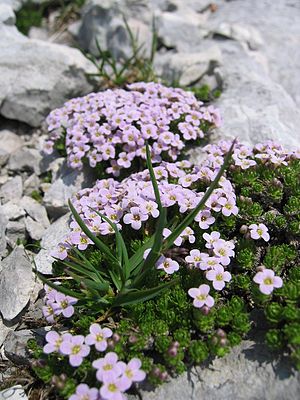Stone jewelry
| Stone jewelry | ||||||||||||
|---|---|---|---|---|---|---|---|---|---|---|---|---|

Gemstone ( Petrocallis pyrenaica ) |
||||||||||||
| Systematics | ||||||||||||
|
||||||||||||
| Scientific name of the genus | ||||||||||||
| Petrocallis | ||||||||||||
| WTAiton | ||||||||||||
| Scientific name of the species | ||||||||||||
| Petrocallis pyrenaica | ||||||||||||
| ( L. ) R.Br. |
The stone jewel ( Petrocallis pyrenaica ), also known as the Pyrenees stone jewel, is the only species of the Petrocallis plant genus within the cruciferous family (Brassicaceae). It thrives in the European mountains of the Pyrenees , the Alps and the Carpathians .
description
Vegetative characteristics
The stone ornament is a perennial herbaceous plant and forms a 2 to 8 centimeter high so-called »hollow ball cushion«, a special form of upholstery growth. A woody trunk is stuck in crevices or rubble, from there radiate, up to 12 centimeters long, root branches emerge. The hard "bark" offers excellent protection against wind drought, sand and snow blowers. The inside of the pillow can store moisture. Compressed parts with rosette leaves and stretched parts alternate. The leaf sheaths are preserved after weathering, so that the cushion is covered by a dense bark on the outside, but hollow on the inside with thin stems.
The leaves are arranged in a basal rosette and are wedge-shaped with a length of 4 to 8 millimeters. They are divided into three to five and ciliate on the edge.
Generative characteristics
The flowering period extends from June to July. The flowers are crowded together in a double-cluster inflorescence . The hermaphrodite flowers have a double flower envelope. The skin-rimmed calyx is reddish. The four free, pink to lilac or light purple petals are egg-shaped with a length of 4 to 5 millimeters and about twice as long as the calyx.
The bald pods are elliptical.
The basic chromosome number is x = 7; there is diploidy with the chromosome number 2n = 14.
Occurrence and endangerment
The stone jewelry occurs in Germany , Austria , Switzerland , France , Italy , Slovenia , Slovakia and Croatia . For example, stone jewelry is widespread in the northern and southern Limestone Alps and in the Pyrenees . It is probably a Nunatakker plant, which is why it was absent in the then glaciated valleys of the Central Alps . It occurs only very locally in Germany and rarely in high-altitude locations in the Alps, and there are adventurous individual finds in other areas of Germany.
The pronounced high alpine plant species is lime and rock-solid and grows at altitudes of 1700 to 3400 meters. It is a character species of the Potentillion caulescentis association, but also occurs in plant associations of the Thlasion rotundifolii associations or in the Caricetum firmae of the Seslerion association.
It is not considered endangered in Germany in 1996. In Bavaria it is classified in category 3 = "endangered" according to the Bavarian Red List 2003 and is considered rare there. Only the wild populations have been strictly or particularly protected according to the Federal Nature Conservation Act in Germany since 1980. This very rare plant species is protected in Austria . In Switzerland, it is rated as “Near Threatened” = “potentially at risk”.
Systematics
It was first published in 1753 under the name ( Basionym ) Draba pyrenaica by Carl von Linné . The genus Petrocallis was established in 1812 by William Townsend Aiton . The new combination to Petrocallis pyrenaica (L.) R.Br. was published by Robert Brown in 1812 . The specific epithet pyrenaica means "from the Pyrenees".
literature
- Xaver Finkenzeller, Jürke Grau: Alpine flowers. Recognize and determine (= Steinbach's natural guide ). Mosaik, Munich 2002, ISBN 3-576-11482-3 .
- Manfred A. Fischer, Wolfgang Adler, Karl Oswald: Excursion flora for Austria, Liechtenstein and South Tyrol . 2nd, improved and enlarged edition. State of Upper Austria, Biology Center of the Upper Austrian State Museums, Linz 2005, ISBN 3-85474-140-5 .
- Jacob Sturm: Germany's flora in illustrations ... - Petrocallis pyrenaica R. Br. Pyrenäisches Steinschmückel , Nuremberg, 1797–1862: Scanned page.
- Hermann Wagner: Illustrierte deutsche Flora , Verlag Hoffmann, 1831: Steinschmückel Petrocallis on p. 68 in the Google book search
Individual evidence
- ↑ a b Petrocallis pyrenaica (L.) R. Br., Pyrenees stone jewelry. In: FloraWeb.de.
- ↑ a b Erich Oberdorfer : Plant-sociological excursion flora for Germany and neighboring areas. 8th edition. Verlag Eugen Ulmer, Stuttgart 2001, ISBN 3-8001-3131-5 . Page 455.
- ↑ Petrocallis pyrenaica at Tropicos.org. In: IPCN Chromosome Reports . Missouri Botanical Garden, St. Louis
- ↑ a b Michael Hassler, Bernd Schmitt: data sheet from Flora von Deutschland - a picture database , version 3.40.
- ↑ Profile and distribution map for Bavaria . In: Botanical Information Hub of Bavaria .
- ↑ Data sheet at WISIA of the BfN.
- ↑ Petrocallis pyrenaica (L.) R. Br. In: Info Flora , the national data and information center for Swiss flora . Retrieved August 26, 2017.
- ↑ Petrocallis pyrenaica at Tropicos.org. Missouri Botanical Garden, St. Louis, accessed October 27, 2015.
Web links
- Stone jewelry . In: BiolFlor, the database of biological-ecological characteristics of the flora of Germany.
- Thomas Meyer: Data sheet with identification key and photos at Flora-de: Flora von Deutschland (old name of the website: Flowers in Swabia )
- Datasheet at Botanik im Bild / Flora von Österreich , 2005.
- Günther Blaich: data sheet with photos.


